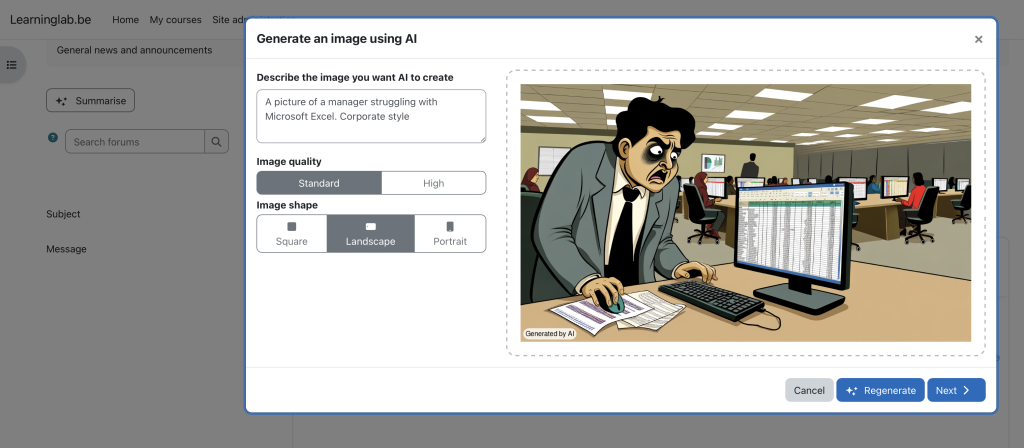Tag: Learning
AI in Moodle 4.5
I took the new AI features in Moodle 4.5 for a spin. Very useful for course admins, down-to-earth, easy to use. One to generate text, another one to generate images, both integrated in the built-in html editor.
More info: https://docs.moodle.org/405/en/AI_subsystem


My top 10 tools for learning in 2023
Jane Hart is gathering votes again for her annual “Top 100 tools for learning“ ranking. It has been a while since I last contributed, it’s time to pick up this good habit again.
Here is my top 10 for this year (in no particular order):
Microsoft OneNote: although I have tried and tested more “fancy” (Notion style) note taking tools, for me OneNote is still the best note-taking application. The web version is powerful, there are clients for most common platforms, including Mac OS.
Wallabag: a self-hosted “Read Later” web application (or Pocket competitor), that allows you to capture websites via a “bookmarklet”, tag and store them for later. You can self host it, which is a privacy advantage.
WordPress: excellent blogging platform. Administration is a piece of cake, even for non-tech users, with e.g. the auto-update feature.
FreshRSS: I’m still old school, so still using RSS feeds. FreshRSS replaced the Fever app (which was no longer maintained by the author). It gathers hundreds of RSS feeds that would otherwise be impossible to follow.
Microsoft 365: the “swiss army knife” of productivity tools: enterprise-grade e-mail and calendar, SharePoint sites for collaborating or storing knowledge, and OneDrive for personal storage.
Freemind: open source mindmapping tool, replacing my earlier (too expensive) MindMeister
X (formerly known as Twitter): I was hesitating to keep this one on the list. The attitude of their new owner and the fact that Tweetdeck (the only way to filter out corporate BS and focus on the people you want to hear from) became a paying option have put me in serious doubt. Maybe the last year…
Microsoft Teams: my daily hub for “informal learning” and “knowledge sharing” with my colleagues. It remains a bit clumsy and managing the “firehose” of information is not always easy, but I’m learning to like it.
LinkedIn Learning: a very rich range of e-learning courses on various subjects. I like the variation in subjects, approaches, level of detail…
Obsidentify: not a “corporate” learning tool, but if you are interested in nature, this app helps you to identify wild plants and animals by simply taking a picture of them.
Merlin Bird ID: same as above, but this time an app for identifying birds by simply recording the sound of them.
Working in Learning Technology in the near future
Donald Clark wrote a very thought-provoking article, a must read, for people that are working in the world of Learning Technology (learning designers, architects, instructional designers…): Learning Designers will have to adapt or die. 10 ways to UPSKILL to AI….
It is time to learn new skills and re-invent ourselves…
My Top 10 Tools for Learning in 2018
Jane Hart is gathering votes again for her annual “Top tools for learning“. You have until September 21 to contribute, and results will be available on October 1.
Here is my top 10 for this year:
- Microsoft OneNote: still the best note-taking application. Unbeatable in combination with SharePoint or OneDrive, and a tablet pc with a digitizer pen (like the Surface, or recently the new iPad with the stylus). It is fully cross platform with a nice and stable client for OS X! (personal and professional learning)
- Wallabag: a self-hosted “Read Later” web application (or Pocket competitor), that allows you to capture websites via a “bookmarklet”, tag and store them for later. For those who don’t want to give all their data away and don’t mind playing with a webserver, it is a must try. (personal and professional learning)
- WordPress: excellent blogging platform. Recent releases have been focussing on the usability for the writer, and it is setting the standards for usability. I’m looking forward to their update that has the new editor. Administration is a piece of cake, even for non-tech users, with e.g. the auto-update feature. (personal & professional learning)
- Office Lens: a Microsoft mobile app (Windows, iOS, Android) that “scans” about everything with the camera of your phone. I especially like the way it “straightens” pictures of documents, whiteboards, flipcharts…
Invaluable for capturing the notes of a meeting, or “scanning” a document when you don’t have a scanner. (personal and professional learning) - Fever: this “self-hosted Google Reader” is still my main information hub, gathering hundreds of RSS feeds that would otherwise be impossible to follow. Fever is unfortunately no longer maintained by his author, but it remains very stable. (personal & professional learning)
- Office 365: the “swiss army knife” of productivity tools: enterprise-grade e-mail and calendar, SharePoint sites for collaborating or storing knowledge, and OneDrive that has 1TB of storage and that is a serious competitor for tools like Google Drive and DropBox. The price is very reasonable and once everything is set up for your domain, it “just works”. (personal and professional learning)
- Mindmeister: mindmapping tool with extensive possibilities and a very good iPad app. (personal and professional learning)
- Twitter: if you don’t mind reading an occasional rant or filtering out the corporate BS, the best way to generate your own “information streams” about various subjects. (personal & professional learning)
- Microsoft Teams: gradually replacing Microsoft Lync as a communication tool, and trying to compete with Slack. I’m still discovering all the possibilities, but the integration with SharePoint and OneNote looks very promising (workplace learning).
- Microsoft To Do: Microsoft recently acquired Wunderlist, and Microsoft To Do will hopefully gradually integrate all the nice features of this “GTD” app. It is still a bit rough on the edges, but with a nice iPhone app and a good Windows client, it is keeping me organised throughout the day. (personal and professional learning)
